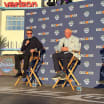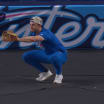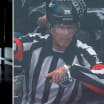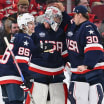Unmasked: Creativity key when replacing outdated equipment
Allen, Price among goalies who stock up on leftovers, call retail stores for old inventory
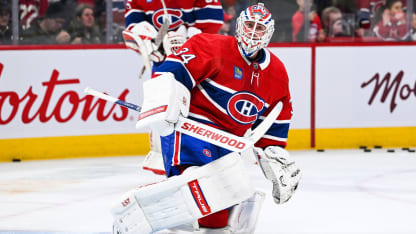
Need a new set of pads to match the team's new-look jersey for a special event? No problem.
Multiple masks, each with a custom paint job from your favorite artist? Done.
Thinking about trying something new from a different manufacturer? Equipment companies are almost always happy to custom build a set.
Are shots starting to sting your glove hand? When your glove starts to break down, just order a new one. Many goalies already have a second, third, and sometimes even fourth, glove sitting in their locker. Better yet, order an extra glove with a special practice palm that's been reinforced with extra padding for all those shots between games.
The only time NHL goalies need to worry about equipment is when it gets discontinued.
For some, that can present a real problem, one that has left goalies stocking up on leftovers from manufacturers, calling retail stores to search through old inventory, or even searching eBay.
Devan Dubnyk finished his 12-year NHL career in 2021 wearing a skate model from 2011.
"They were one of the first goalie skates that came out from Reebok," said Dubnyk, who played his final five games with the Colorado Avalanche after being acquired prior to the 2021 NHL Trade Deadline. "I was still with the [Minnesota] Wild when they told us they couldn't make them anymore and only had six pairs left, so we bought them all. I joked with the guys in Colorado that I only had two pairs so I had two years left at most and, hopefully, I didn't play too good because when 'I'm out of these, I am done.'"
Finding older models of pads and gloves isn't typically an issue.
Most equipment manufacturers will customize newer versions of pads to meet personal preferences, whether its Marc-Andre Fleury of the Wild wanting leather straps and metal buckles on otherwise modern pads long after Velcro became the standard; or New York Islanders' No. 1 goalie Ilya Sorokin wanting a knee stack that's independent from the face of the pad even after Bauer integrated them on stock models to create a better seal to the ice.
Masks haven't been an issue since goalies stopped wearing helmet and cage combos more than a decade ago, but back then the quest to find that Cooper SK2000 helmet left goalies and equipment managers searching the internet for parts.
Chris Osgood once had to rely on automotive bumper paint to change colors after being traded, and later ended up wearing shells from the Red Army program in Russia after the Detroit Red Wings found out a team masseur had a bunch in his garage in Moscow.
Some goalies run into problems finding old accessories.
When one company stopped making a knee sleeve with impact-absorbing foam that helped ease the blow of dropping into the butterfly about five years ago, Carey Price worried how long his supply at the time would last. When an acquaintance discovered a box of the discontinued sleeves in the back of a hockey store in Vancouver and alerted Price, he had the Montreal Canadiens equipment staff buy enough to get him through the rest of his career.
Price's former playing partner still wears a set of kneepads from 2009 and relies on the Canadiens equipment staff to keep them functional after 14 seasons of NHL action.
"I'm going to use these until I die," Canadiens goalie Jake Allen said. "They keep re-sewing them for me. These are my one thing that I will never be able to switch. Everything else is standard."
Thatcher Demko has worn the same goalie jock since college seven years ago, but presumably the Vancouver Canucks goalie would be able to switch if the need arose.
Arizona Coyotes backup Connor Ingram finally had to switch from the stick he'd used for seven seasons because they don't make them anymore. Tampa Bay Lightning veteran Brian Elliott found a different supplier so he could keep using a wood-based stick long after everyone else switched to composite.
Skate switches, however, remain problematic for several goalies.
The Canucks resorted to calling local hockey stores to try to find an older model for Spencer Martin because the updated version didn't have the same clearance on the inside edge of the boot just below the big toe when he was pushing side to side from his knees.
"We actually went to the store and just bought a stock pair off the wall," Martin said.
Skates are especially tricky because any changes to the stiffness, height of the blade holder under the boot, or the pitch angle of either can affect a goalie's balance. Even subtle changes to posture on the skates can throw off stance and movement mechanics for a goalie.
That's why Dubnyk couldn't switch. Every time he tried in the offseason, it felt like he was on his heels and the shorter blade on newer models made it harder to push from his knees because he relied on longer blades and a more flexible boot to grab an edge on the toe of the skate.
"I always just felt vulnerable," Dubnyk said. "It was awful."
Darcy Kuemper of the Washington Capitals has been experimenting with different options ever since the holder on the skate brand he was wearing changed two seasons ago.
Casey DeSmith went through similar struggles last season with the Pittsburgh Penguins while trying to play through subtle changes to an updated skate model. A higher ankle changed the pitch angle, and a stiffer boot and longer skate tongue made it harder to flex forward.
"I went from being on my toes and having a lot of forward flex to feeling I was always on my heels," DeSmith said. "My upper body and hands pulled back. It was a mess."
DeSmith finally ended up switching back to his old skates in the middle of a game in late January and started to feel and play better almost instantly. He spent the offseason finding another skate option that provided the same balance points and forward pitch as his old skates.
"I've never looked back," DeSmith said.
When equipment gets discontinued, goalies sometimes don't have a choice, even in the NHL.
